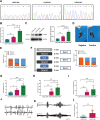Exploratory analysis of a Novel RACK1 mutation and its potential role in epileptic seizures via Microglia activation
- PMID: 39891152
- PMCID: PMC11786535
- DOI: 10.1186/s12974-025-03350-5
Exploratory analysis of a Novel RACK1 mutation and its potential role in epileptic seizures via Microglia activation
Abstract
Seizures is a prevalent neurological disorder with a largely elusive pathogenesis. In this study, we identified the key gene RACK1 and its novel mutation RACK1-p.L206P as being associated with seizures through single-cell transcriptome sequencing (scRNA-seq) and whole exome sequencing (WES) techniques. Our findings reveal that the RACK1-p.L206P mutation significantly enhances proliferation, migration, phagocytic ability, and inflammatory activation in human microglia, which in turn affects neuronal excitability and synaptic function, culminating in typical seizure symptoms in the seizures. These effects were further validated in a mouse model using CRISPR/Cas9 gene editing technology. Mutant microglia exhibited increased activation and induced apoptosis in hippocampal neurons, leading to higher action potential frequency and excitatory synaptic marker expression. In vivo experiments demonstrated that RACK1-p.L206P mutant mice displayed classic seizure symptoms, with increased neuronal excitability and a tendency for action potential bursts during initial depolarization, along with more frequent spike discharges. Additionally, excitatory synapse density and size in the hippocampal CA1 region of mutant mice were significantly elevated, accompanied by increased expression of VGLUT1 and PSD95 within microglia. This study offers novel insights into the molecular mechanisms underlying seizures in the seizures and presents valuable clues for the development of future therapeutic strategies.
Keywords: CRISPR/Cas9; Microglia; Neuron; RACK1; Seizures; Whole exome sequencing.
© 2025. The Author(s).
Conflict of interest statement
Declarations. Ethics approval and consent to participate: All animal experiments conducted in this study were approved by the Institutional Animal Care and Use Committee (IACUC) of Sun Yat-sen University (Approval No. SYSU-IACUC-2020-B0278). Competing interests: The authors declare no competing interests.
Figures












References
-
- Brolin RE, Semmlow JL, Sehonanda A, et al. Comparison of five methods of assessment of intestinal viability. Surg Gynecol Obstet. 1989;168(1):6–12. - PubMed
-
- Yacubian EMT, Kakooza-Mwesige A, Singh G, et al. Common infectious and parasitic diseases as a cause of seizures: geographic distribution and contribution to the burden of epilepsy. Common infectious and parasitic diseases as a cause of seizures: geographic distribution and contribution to the burden of epilepsy. Epileptic Disord. 2022;24(6):994–1019. 10.1684/epd.2022.1491. - PubMed
MeSH terms
Substances
Grants and funding
- Grant No.2021A1515220116/The Natural Science Foundation of Guangdong Province
- Grant No. 202201010071/Science and Technology Program of Guangzhou
- 2023A03J0960/Science and Technology Program of Guangzhou
- Grant No.FTWS2023083/Futian Healthcare Research Project
- Grant No.82001370/National Natural Science Foundation of China
LinkOut - more resources
Full Text Sources
Medical
Miscellaneous

